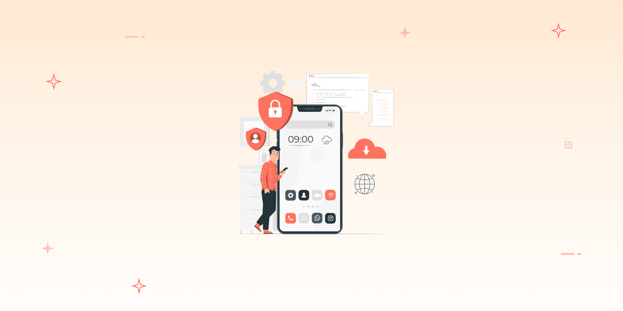
BLOG

BLOG
Full-fledged security is what every one needs! Due to the significant rise in cyber and malware attacks on the different apps, mobile app security is considered a critical component of app development. Therefore, having a highly secured mobile app ensures a hassle-free business operation!
Whether your device is for professional or personal use, you need to protect a heap of data that you've stored. Also, there has been a constant financial risk associated with various mobile apps offering in-app buying options. So, how do you keep your business protected from such malicious attacks?
Various mobile applications accumulate behavioral data in the app background! Hence, it would be best if you prioritized mobile app security testing more than anything as a business owner.
So, it's time to mull over the potential risks and increase app security with a complete checklist!
Are you ready to explore more?
In today's blog, we will discuss a mobile app security checklist, which developers and business owners must consider for enhanced security for their users. Let's get started!

A destructive weapon of a hacker is open-source software. They have always had an effortless time stabbing such software with malware. The top-notch therapy is to bypass software exhibiting publishers and safeguard your apps from adversarial cyber assaulters. However, the software code should be intact and secure with a code signing certificate that helps prevent malware multiplication and makes it 100% unsusceptible to the attackers. A few famous code signing certs are Comodo code signing certificate, Symantec code signing certificate, and Sectigo code signing certificate.
As the hackers count heavily on pilfering private keys to imbue malware into a code, it's essential to keep this top-notch code signing certificate in a secure place. You will get complete protection of all your files and safeguard those by setting non-intruding and unique passwords.
With the surge in threats like man-in-the-middle and snooping attacks over cellular and Wi-Fi networks, IT must ensure that every communication between mobile app servers remains encrypted. Powerful encryption, which leverages session-oriented key exchanges and 4096-bit SSL keys, can impede the most determined hackers from deciphering communications.
However, IT should ensure that the sensitive data preserved on the user's device is encrypted besides encrypting traffic. As far as ultra-sensitive data is concerned, IT must want to safeguard data from being downloaded to the end user's phone.
Are you wondering about how to secure mobile apps? Smartphone users don't prefer redundant authentication and checks on their devices. Therefore, password preservation is one of the most critical mobile app security measures! It ensures no one can use your device and can be programmed to take corrective measures if a theft case ensues.
Convenience is the ultimate key to every mobile app developer, and they've made it more powerful. Hence, users must not feel afflicted by such authentication appraisals. This multi-factor authentication implies that 2-3 steps are added to deploy protection. However, this can be a combination of biometric verification, pins, calls, messages, and security questions.
RASP tools hinder potentially perilous activities when a program is in production. This tool monitors a company's application in real-time, analyzing both the context and behavior it occurs.
If RASP finds out a security event, for example, a suspicious effort to roll out a shell, call a database, or open a file without properly authorized access, it will try to stop it right off the bat!
In addition, RASP helps secure mobile apps and protects against SQL injection and cross-site scripting along with zero-day susceptibilities and account takeovers.
APIs are crucial to merging third-party services and boosting functionality, allowing heterogeneous systems to interconnect and facilitate data exchange. However, you need top-notch and highly secured APIs for improved mobile app security and don't expose the data swapped. In brief, the best-in-class way to ensure API security testing is to leverage complete data access authorizations.
Various technologies and tools give countless warning signals when an app code is modified or tampered with. Therefore, you need to embellish your app tactfully to provide a warning indication when any changes have been made in the code.
This is how if any malicious code has been infiltrated into your app, tamper-identification software will make sure that the code doesn't operate for mutation. The leading tampering strategies are injection and binary patching, including alteration in Java bytecode and transformation in code. However, code injection is a vital strategy to revise the process for your information.
SAST, aka Static Application Security Testing strategy, is vital to investigate your application codes' mobile app security loopholes and emphasize them. Furthermore, they help scan the code for susceptibilities and take adequate action to mend the security loopholes.
Such testing will help you discover if any hazardous activities or unauthorized access are there. For penetration testing, various tools are available, such as Apktool, Cydia, and Appcrack. Lastly, app investigation needs proficiencies, such as reverse engineering, assessment of files, and decryption of data.
To circumvent data leaks while allowing users to install various personal apps on their smartphones, IT should isolate business apps from personal ones. Therefore, building secure mobile workspaces help restrict malware from accessing corporate applications and impedes users from imitating, disseminating, or saving sensitive data. However, for ironclad data leak deterrence of personal data:
To conclude, you need to secure mobile apps as the threat of hackers is looming in 2022, taking duping attributes and practices to jailbreak a mobile app. If you fail to prioritize mobile app security for your business, hackers can quickly get into your app and steal your private business data.
Follow the mobile app security checklists mentioned above to stop them from hacking your app. Also, read why do hackers hack? However, if you are intrigued by the information provided above, inform us which practices you have deployed for sustaining your business in the long run!
